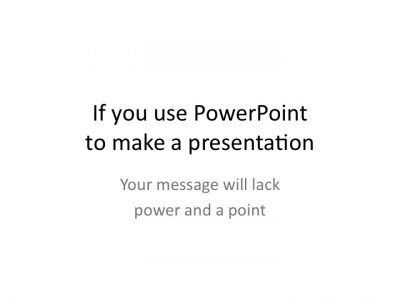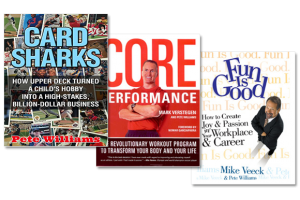That A+ came in Public Speaking as a freshman in 1988, two years before Microsoft officially launched the corporate plague that is PowerPoint, now embraced by everyone from the military to businesses to academics as the training wheels of public speaking, the lazy person’s way to make a presentation, the guaranteed way to suck the energy and enthusiasm out of a room.
The problem with a PowerPoint presentation is that it has neither power nor a point. Powerpointless, it’s often dubbed. It’s no coincidence that PowerPoint presentations stink.
When you speak with nothing more than notes, if that, you’re forced to convey your message precisely and effectively. Without the crutch of PowerPoint, you’re inspired to practice your talk many times, which automatically makes you hone your message and timing, thus making your delivery tighter and more compelling.
Stand-up comedians understand this. So do actors, broadcasters, commencement speakers, preachers, motivational speakers, effective teachers, and even politicians, though admittedly most of them are the human equivalent of wind-up dolls, repeating a dozen familiar talking points.
There’s nothing lean about PowerPoint presentations. They’re bloated with stats, figures, graphs, charts, research, stock photos, and other yawn-producing clutter and filler that steal the power from your message. There’s nothing wrong with video snippets or a few photos. I once watched an executive from ESPN deliver a speech pegged to the history of the sports network by calling up familiar ESPN house ads from over the years. It was effective, funny, and memorable.
Usually PowerPoint fails. There are junior officers in the military that spend most of their time doing nothing but creating slide decks. Ditto for folks in the corporate world. We’ve trained a generation of kids in schools on PowerPoint instead of public speaking. What a waste of human capital all around.
Last week I attended a three-day conference where every speaker delivered a PowerPoint presentation, one after another. Some panels had five presenters, each droning on via PowerPoint for 20 minutes each. It was torture.
One panel consisted of five lawyers. That’s two hours of my life I’ll never get back. There’s nothing worse than listening to a group of guys conditioned to talk long – since they bill by the hour – deliver PowerPoint presentations. If there is a hell, I imagine it will consist of listening to lawyers go through slide decks.
In fairness, one lawyer didn’t use PowerPoint. He got up and spoke off the cuff for about 10 minutes. Maybe he went longer, but it didn’t seem that way. He told amusing stories and anecdotes, railed against the hypocrisy of his little corner of the legal world, and spoke with passion. A week later, I don’t recall a word he said but I do remember his delivery and enthusiasm.
There’s no more underrated skill in life than the ability to speak effectively in public. That’s why I’m so proud of that A+ in Public Speaking. It took a lot of practice that semester to tweak each one of those speeches, none of which I delivered with more than a prop or two. The routines and rituals I learned to prepare and deliver talks in that class I still turn to more than 25 years later. If you weren’t fortunate to take public speaking in school, there are plenty of opportunities. Thankfully Toastmasters still is thriving. It’s now teaching a lost art.
The next time you’re asked to present a PowerPoint presentation, ask if you can go without the slide deck. If someone insists, just go with a couple of video shorts (10-15 seconds max) or a few photos. Skip the bullet points and all of the numbers. Practice your presentation in front of the mirror with a stopwatch at least a dozen times so that you can deliver it without notes. I bring notes just in case, but I rarely use them. I end up rolling them up and using them as a prop, like a basketball coach on the sidelines.
Get the audience looking at you, not a boring slideshow. If you get uncomfortable making eye contact during a speech, glance from person to person, looking at their hairlines. They’ll still think you’re looking at them.
By speaking this way, you’ll come across as more confident, smart, powerful, and funny. The audience will listen to your message and remember it. You’ll learn that butterflies are merely a burst of adrenaline that will drive you to deliver the talk naturally, since you’ve practiced it a number of times already.
You’ll have the satisfaction that comes with commanding an audience and nailing the speech. It will advance your career and business. You’ll get lean in yet another aspect of your life, cutting the fat and excess time from presentations and developing the ability to deliver messages quickly and effectively.
And you’ll put another nail in the coffin of PowerPoint.



